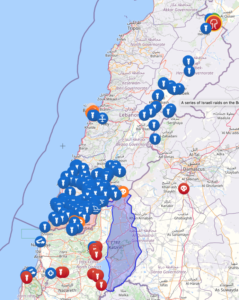Happy Valentine’s Day! Or, as I call it in my house, “Passover.” DOGE uncovers more infuriating waste and fraud, another job number revision downward, a bit on the Russo-Ukrainian War, a Second Amendment ruling, and the Babylon Bee offers up a double-shot of Tolkien.
It’s the Friday LinkSwarm!
The Department of Health and Human Services spent $22.6 billion on assistance to illegal immigrants from 2020 to 2024 as border crossings hit all-time highs, a new watchdog report shows.
The HHS Office of Refugee Resettlement, a unit that lost track of 32,000 migrant children, distributed the bulk of the funds to nonprofit organizations during President Joe Biden’s term, according to a report from government spending watchdog Open the Books, first reported by the New York Post.
In fiscal year 2023 alone, the ORR doled out $10 billion worth of grants as the Biden administration expanded the number of illegal aliens eligible for assistance. HHS distributed obligated funds of $2.6 billion in 2020, $2.3 billion in 2021, and $4.2 billion in fiscal year 2024. Over that time period, the Biden administration allowed record numbers of illegal immigrants to cross the southern border and remain in the country.
Some of the ORR money went towards a program that helped illegal immigrants save for car and home purchases, while another program distributed business and personal loans to help migrants build credit. Additional funds were allocated toward providing migrants with “legal assistance,” “cultural orientation,” and “emergency housing support.”
“ORR is part of a troubling trend of using nonprofit groups as ideological proxies. Vast sums are being outsourced to evade accountability and prop up an immoral, exploitive system that is hurtful to both American citizens and people in other countries who are longing for a better life,” Open The Books CEO John Hart told the Post.
Elon Musk’s nerd army stormed into the Department of Education on Tuesday and saved over $900 million.
Musk’s DOGE lieutenants Akash Bobba and Ethan Shaotran, both 22, already have access to the department, NBC News reported.
And as many as 16 DOGE team members have entered the premises as the agency begins to be ripped apart.
Rep. Melanie Stansbury, (D-NM) described the terror agency staff are feeling after Musk’s team entered to ‘actively dismantle’ the institution.
‘They are in the building, on the 6th floor, canceling grants and contracts,’ she said in an interview with HuffPost.

The Department of Education was targeted by Donald Trump during his campaign, He is keen to dismantle the so-called ‘Deep State’ constantly working against conservatives.
Most Republicans believe the department employs some of the most activist liberal bureaucrats in the federal government.
Trump plans to sign another executive order on Tuesday to order all agencies to work with DOGE, according to Semafor, including with the ‘workplace optimization initiative.’
Snip.
The department has already terminated 89 Education Department contracts worth $881 million.
And over 29 training grants for DEI have been eliminated saving $101 million, according to the DOGE X account.
President Donald Trump campaigned on shutting down the Department of Education and sending the funding back to the states to fund their schools as they see fit.
Gooder and harder. (Hat tip: Stephen Green at Instapundit.)
Over the last two years, USAID had funneled $2.3 billion in “humanitarian assistance” to [Ilhan] Omar’s native Somalia. Last year it reported a request for $1.6 billion in aid and even with the Biden administration on the way out the door, it sent an additional $29 million in December 2024.
USAID support for Somalia had doubled under the Biden administration and with $3.3 billion from USAID allocated in the last 5 years, the end of the USAID gravy train for the Islamic terrorist state of Somalia must have been a painful blow for Omar, who is very close to the Somali regime. Former Somali Prime Minister Hassan Khaire had reportedly celebrated that “the interest of Ilhan are not Ilhan’s, it’s not the interest of Minnesota, nor is it the interest of the American people, the interest of Ilhan is that of the Somalian people and Somalia.”
It’s unknown if any of Omar’s Majerteen clan members benefited from the billions in American money, but considering the prominence of the clan in Somali politics, it’s likely to be the case.
Somalia, along with other Islamic terrorist entities, including the Taliban in Afghanistan, the Houthis in Yemen, and Hamas in Gaza, were among the top beneficiaries of USAID cash.
USAID boasted of having sent $2.1 billion to Gaza and the West Bank since the Hamas attacks of Oct 7. In 2024 alone, $917 million was programmed for the terrorist areas occupying Israel.
USAID provided over $3.7 billion to Afghanistan since the Taliban took over with $832 million in the previous fiscal year alone. The money was so unaccountable that USAID refused to cooperate with the U.S. Government’s Afghan War watchdog tracking money going to terrorists.
Even while the United States of America was at war with the Houthis, the Iran-backed Islamic terrorist group firing on US Navy vessels, USAID continued to direct billions of dollars to Yemen.
In 2024, USAID announced a $2.7 billion aid request for Yemen and allocated $753 million. In the last 5 years, USAID provided an estimated $3.4 billion in aid to an enemy terror state.
Other Islamic terrorist states that have heavily drawn on USAID include Pakistan which harbored Osama bin Laden, but benefited from $600 million in the last 5 years. While some American towns and cities lacked clean drinking water, USAID labored to build plants for Pakistan’s majority Muslim population even while it engaged in the persecution of Christians.
USAID spent over $700 million on Iraq during the last 5 years even though the country has long since been governed by Iranian puppets whose militias have been firing on American soldiers.
$3.4 billion was directed to Syria over the past 5 years by USAID even as it was caught in a civil war between Shiite Islamists aligned with Iran and Sunni Islamists aligned with Al Qaeda.
USAID allocated $1.1 billion to spend on Lebanon even as the country was run by Hezbollah.
While USAID is unable to function in Iran, between Yemen, Lebanon, Syria and Iraq, over $8 billion was sent to Iranian puppet regimes even without counting the money spent on Gaza.
In total, USAID had spent some $18.5 billion on Islamic terror states over those 5 years.
PA Administrator Lee Zeldin said in a video released on Wednesday night that his agency has discovered an unprecedented scheme that was utilized by the Biden administration to funnel money to far-Left activist groups.
“An extremely disturbing video circulated two months ago featuring a Biden EPA political appointee talking about how they were ‘tossing gold bars off the Titanic,’ rushing to get billions of your tax dollars out the door before Inauguration Day,” Zeldin said.
He continued, “The gold bars were tax dollars, and tossing them off the Titanic meant the Biden administration knew they were wasting it.”
Zeldin said that he has contacted the U.S. Justice Department and the inspector general to launch investigations into the $20 billion that was transferred to an outside financial institution for the purpose of doling out funds to leftist organizations during Biden’s final days in office.
“Fortunately, my awesome team at EPA has found the gold bars,” he said. “Shockingly, roughly $20 billion of your tax dollars were parked at an outside financial institution by the Biden EPA.”
“This scheme was the first of its kind in EPA history, and it was purposely designed to obligate all of the money in a rush job with reduced oversight,” he continued. “Even further, this pot of $20 billion was awarded to just eight entities that were then responsible for doling out your money to NGOs and others at their discretion with far less transparency.”
He said that the financial agreement with the bank needs to be instantly terminated and the funds need to be returned to the government.
Let the prosecutions begin.
- $2M sex change surgeries in Guatemala
- $20M to increase tourism in Egypt
- $520M for consultants to teach people in Africa about climate change
- $4.5M to teach people in Kazakhstan to fight back against internet trolls
- $15M for condoms to the Taliban
People need to understand what Trump is doing, whether it’s intentional or not, but he is cutting off the flow of money to the pool from which a variety of left-wing groups and activist groups around the world and in the US drink.
So imagine a pool that’s being filled with money. A lot of that money comes from the programs that have been cut off by his DEI orders, Federal funding.
But a lot of it came from USAID, which is essentially an international development and development agency of the government, which has a massive, tens of billions of dollars, budget. And now we know what has been happening.
It has been like a fire hose filling up the same pool that the DEI funding filled up, and they all drink from that, and he’s cutting off that flow.
This has the potential to be absolutely devastating to the DEI and left-wing industrial complex.
We always think of it as being George Soros and people like that, and, and it is, but they all are feeding into the same pool. And Soros doesn’t have enough money to replace what the US government spends on this stuff.
That’s why they are apoplectic. That’s why they are losing their minds. That’s why they are senators are trying to break into buildings. That’s why there’s a lawsuit after lawsuit because they know if Trump is successful in cutting off the various spigots that fill the pool from which left-wing activist groups drink, they are in big trouble.
The federal judge who ordered the Trump administration to unfreeze all funding pauses while federal spending is being assessed, has a history of anti-Trump and woke activism.
Chief Judge John McConnell Jr. of the U.S. District Court in Rhode Island can be seen in video footage from 2021 accusing Trump of being “a dictator” and claiming that “racism is a white people problem” and that “we all have racism inside of us.”
Judge McConnell certainly has stupidity inside him…
Viking was not at his normal base in the Zhytomyr region when the war started, he was in Kyiv. His race to Zhytomyr was frustrated by a lack of rail services out of the capital and ended with a walk between 25-30 miles to get to the air base, still in civilian clothes. Once there, he was very quickly in the thick of action, and from Feb. 25 on he flew air defense missions that he described as “deterrence,” first flown in daylight and later at night, over the Kyiv region.
“We held them back,” Viking explained. “If their aircraft had come here and worked freely, everything would have been completely different.”
Viking and his fellow 39th Tactical Aviation Brigade (39 BrTA) pilots faced a significant disadvantage in terms of radars and missiles compared to the Russians. While Ukrainian fighters could occasionally track enemy aircraft, getting within missile-launch range was rarely possible.
The Ukrainian Air Force began the war with around 32 Su-27s operational within two brigades, the 39 brTA at Ozerne in the Zhytomyr region of northwestern Ukraine and the 831 brTA at Myrhorod in the Poltava region of central Ukraine. At least 15 Ukrainian Flankers have been visually confirmed as destroyed but, in the meantime, additional examples have also been returned to airworthiness after overhauls. The aircraft are also regularly moved around between different operating locations, some of them austere in nature, making it harder for the Russians to target them.
Snip.
In these early days, Viking’s available intelligence on Russian air defenses was scrawled on a piece of map that he’d torn off, with information vital for survival being exchanged by word of mouth between pilots. The map simply showed the best route into a given area, with circles showing the approximate engagement ranges of hostile air defenses.
The primary job at this time was attempting to blunt the advance of Russian tactical aircraft flying from Belarus. “We were the only ones here, to put it bluntly. We were the first line of defense, and they were constantly trying to sneak their Su-34s and Su-35s in at night, at extremely low altitudes.”
Complicating their job was the fact that, according to Viking, the avionics and missiles of the Ukrainian Su-27s, at this time, were “two generations behind” those of the Russians. Within these parameters, “the battle was reduced to trying to get closer to [the Russians].” But even if that was possible, the Ukrainian Su-27 pilots were rarely able to get within the launch parameters of their missiles, with the Russian jets always having the opportunity to launch weapons first.
“Even though our [missile] launches had short ranges, we still tried something, we launched missiles, we held the Russians back, and we repelled these attacks every night,” Viking explains. “Almost every pilot flew two, sometimes three sorties each night.”
Also a lot of interesting discussion about how western munitions (HARM missiles and JDAMs in particular) have improved their chances.
Pearson, Georgia is a small town, with a population of 1,821 per the 2020 census. Robert “Buster” Johnson is the mayor.
“Buster” was busted yesterday.
I’m just going to quote the list of charges here:
- Criminal Attempt to Commit Hindering or Apprehension or Punishment of Criminal
- 3 counts of Influencing Witnesses
- Criminal Solicitation to Commit False Statements and Writings
- Criminal Solicitation to Commit False Official Certificates or Writings by Officers or Employees of a State and Political Subdivision
- 2 counts of False Statements and Writings
- Criminal Attempt to Commit Theft by Taking
- Conspiracy in Restraint of Free and Open Competition
- 4 counts of Conspiracy to Defraud State and Political Subdivision
- Theft by Deception
- 3 counts of Bribery
- 2 counts of Theft by Taking
- Fraud, Forgery, and Theft in Connection with Registration of Title to Land
- Filing False Documents
- 4 counts of Violation of Oath of Office by Public Officer
Given Andy Ngo’s highlighting of Johnson’s posts charging racism, I think I’ll go out on a limb and guess he’s a Democrat…
A friend of the student’s mom, Heather McCormick, accused a female teacher of grooming the teen girl at school. According to the allegation, she then worked with the school to secretly change the girl’s status to “homeless” so she could legally move out of her parents’ home … and into the teacher’s home.
The unnamed mom discovered thousands of phone calls and texts between the two, which revealed that the female teacher had, at the minimum, been making out with the student.
When the student’s mom went to the principal to let him know that a predator teacher had been sexually grooming her daughter, this is how the principal reportedly responded: “Ms. Kearney takes interest in helping kids navigate their sexuality.”
In two speeches given less than 24 hours apart in the French city of Toulouse, Jean-Luc Mélenchon delivered some of the most shocking yet brutally honest words from a European politician, openly calling for the older French to be replaced by a “Creole” generation of mixed races and cultures.
The leader of France’s far-left LFI is calling outright for replacement of White French people, conjuring up the Great Replacement term that has been demonized as a conspiracy theory by the left for years.
“In our country, one person in four has a foreign grandparent. 40% of the population speaks at least two languages. We are destined to be a Creole nation and so much the better! May the young generation be the great replacement for the old generation,” said Mélenchon.


I’m between jobs again. Feel free to hit the tip jar if you’re so inclined.





 (@iAnonPatriot)
(@iAnonPatriot)